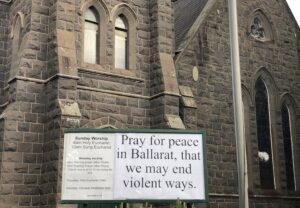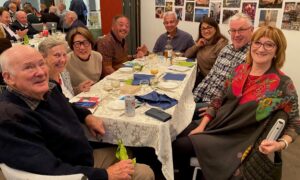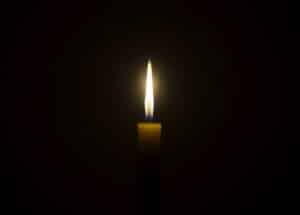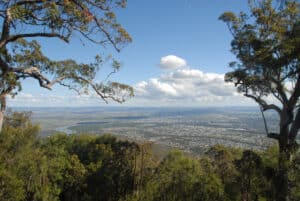Graeme Garrett says the latest novel by a Booker Prize-winning Australian writer is changing him in its weaving of one human being’s dying struggle with the perils of our planet.
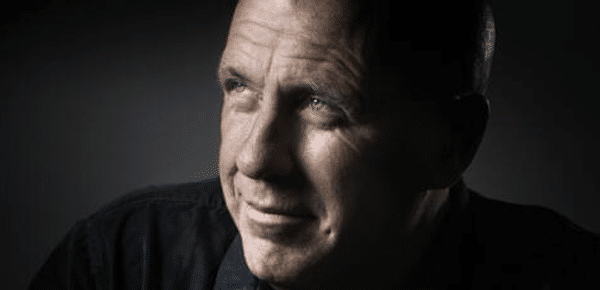
By Graeme Garrett
9 March 2021
More important than “a book that changed me” is a book that is changing me. This one certainly is. Richard Flanagan’s latest novel, The Living Sea of Waking Dreams, which the author describes as “a rising scream”, is a fierce and utterly clear-eyed exploration of the world in which we now find ourselves. Set in Tasmania at the height of the terrible fires that ravaged huge tracts of Eastern Australia in the summer of 2019-20, the book tries to bring to speech – not in the technicalities of science or the platitudes of politics, but in the common language of ordinary people – the catastrophe, so much of our own making, in which we, and all other creatures with us in this land, are now living – and dying.
No easy task. How can you put into words the town of Mallacoota incinerating like a pine coffin in a cremation oven, inhabitants huddled on the beach under a blackened sky raining fire? What do you say about a billion creatures, wild and domestic, turned to soot? Flanagan’s book opens with this struggle to find words. Sentences break down in full flight. Words pile up against each other, twisted somehow for being asked to carry too much. “As if they too were already falling apart, so much ash and soot soon to fall, so much smoke to suck down. As if all that can be said is we say you or if that then.” (page 3). Flanagan is a brilliant architect of language. He is determined to build a bulwark against the rising tide of Trumpspeak, where “everyone [is] using words to avoid using words for what words were used for” (p.235), that is to tell the truth. But one thing is clear in our smoky times. The truth is hard to hear.
The megaphone Flanagan chooses to make his raid against our deafness comes in the form of a family of four, reluctantly drawn together in a ward of a Hobart hospital. Francie, the mother, has suffered a brain bleed. Already in her mid-80s, the medical advice is to let nature take its course. The family can ease Francie’s final journey with expert palliative care. Tommy, the eldest son, an unsuccessful artist with a tendency to stutter, but to this point his mother’s constant carer, agrees. Let her die with dignity. Terzo, the youngest of the three, a venture capitalist back from his business on the mainland, won’t hear of it. Anna, the middle child, a highly successful architect living in Sydney, goes along. She and Terzo have money and power. And they intend to use it for good. Francie is delivered to the surgeons. From there the story unfolds as the full force of modern medical technology is brought to bear against their mother’s encroaching demise; against her express wish “to let me go”. Anna and Terzo are convinced of that basic tenet of modernity, “that nature would always bow to will, and that their will would have its way in all things” (p.152). The slow and ghastly outcome of this battle of the Titans (technology versus death) is that Francie’s now emaciated body is reduced to an entanglement of “dialysis machinery, feeding stations, oxygen intubation, tubes and IV stands festooned with bags full of vital fluids, opioids, antibiotic, supplements” (p.211). Binding her to pain, dementia and uncomprehending anguish.
The tensions, spoken and unspoken, of the human drama that unfolds remorselessly in the claustrophobia of Francie’s hospital room, plays out against a cosmic backdrop of Tasmania’s ancient forests and fields ablaze – oppressive and omnipresent, yet somehow just out of focus for the feuding siblings. Giant fire-generated clouds 16 kilometres high generate “more fire through lightning, ember attacks, wind, fire tornadoes” (p.103). In her Airbnb, Anna awakes each morning to find her sheets speckled with sooty fragments, the carbonised remnants of “thousand-year old King Billy pines and ancient grass trees … and the tiny rare mountain orchards” (13). Mother Nature is also in extremis, hounded to the brink by the same forces that dictate action inside the air-filtered sick-room – money, power, technology. Here, their mother is intentionally forced to endure a drawn-out living death, which Tommy regards as against nature. Outside, with ever accelerating speed – and (also) against her wishes – Mother Earth is inadvertently being pushed toward a tipping point where all life as we know it comes under threat. Anna feels helpless in the face of both battles. “Other than keep her mother alive as everything died”, she “could do nothing and would do nothing” (p.98).
Central to Flanagan’s concern is what he calls “the vanishing”. In the human realm, this manifests as a “silent leprosy” (p.47) in which parts that belong to the human body – Anna’s mainly – suddenly aren’t there anymore. Anna first notices that the fourth finger on one hand is missing. This is followed by a knee, another finger, a breast and an eye. The worst of it is that by and large nobody notices, not even medical practitioners. Anna herself is strangely indifferent. “The only surprise for her was how little she felt about feeling so little” (p.151). Beneath this human apathy to human deconstruction, overheated Tasmania drives the vanishing ever faster and wider. “The ladybirds gone soldier beetles bluebottles gone earwigs you never saw now gone … flying ant swarms gone frog call in spring cicada drone in summer gone … and all around them the quolls potoroos swift parrots going going going” (pp.6-7). On a Hobart tram, nobody takes any notice. All are staring at their phones, searching, liking, friending, commenting, emojiing, cancelling, swiping, scrolling. “Thinking they were no more than writing and rewriting their own worlds, while all the time … they were themselves being slowly rewritten into a wholly new kind of human being” (p.224).
A flinty harshness stalks the pages of this book. Flanagan uses words for what words used to be used for: to show us ourselves and the global context we have engineered with our money, power and technology. It’s not flattering. But neither is it judgmental, cruel or cynical. The Living Sea of Waking Dreams is a lament arising from love of the Earth and passionate hope for the future of our human place within it. It ends with a gesture of adoration for “that immense gift, the intense gratitude” (pp.282) that wait to be called forth from our souls by the beauty and generosity of the earth around and within us. The meaning of this gesture and its entanglement in the lives of Francie’s children is an adventure that awaits your reading of the text.
Perhaps it will change you. It’s certainly changing me.
Richard Flanagan’s The Living Sea of Waking Dreams is published by Knopf: Penguin Random House Australia 2020.
The Revd Dr Graeme Garrett is a retired Anglican priest and theologian, living in Melbourne. He is passionately concerned for the Earth as God’s good creation and our (human) home, shared with so many wondrous creatures.


